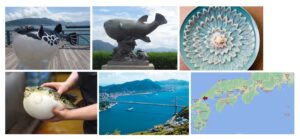Me: “This plate of sashimi is really beautiful. What is it?
Mr. Inoue: “It is fugu. Japanese blowfish. Very expensive.”
Me: “Wait, isn’t that poisonous?”
Mr. Inoue: “Sometimes. But perhaps today we are lucky.”
When it comes to food, I’m not really into Russian roulette. But that’s exactly the experience you sign up for when you order a plate of fugu in Shimonoseki, Japan, the national capital for poisonous blowfish. According to Wikipedia:
“Fugu contains lethal amounts of the poison tetrodotoxin in its organs, especially the liver, the ovaries, eyes, and skin. The poison, a sodium channel blocker, paralyzes the muscles while the victim stays fully conscious; the poisoned victim is unable to breathe, and eventually dies from asphyxiation.”

In other words, when you bring a bite of fugu to your mouth, you are trusting your life to a chef whom you can only hope is competent. If they’re not, you’ll be dead by the end of your meal! Why would anyone do this??? Well, for one thing, fugu is delicious and gives you a nice little tingly buzz when you eat it. For another thing, the chefs are all highly trained. In fact, only qualified “fugu handlers,” who have served a 3-year apprenticeship, can serve fugu meals. According to the Tokyo Bureau of Welfare and Public Health, there are less than 6 deaths per year from eating fugu, and most of them are from eating fugu that was caught and eaten privately rather than at a sanctioned restaurant. So yes, eating fugu in Japan is pretty safe.
Of course, I knew none of this when I first arrive in Shimonoseki as a callow, 22-year-old English teacher. After meeting my boss, Mr. Inoue, up north in Tokyo, we ride the bullet train 4 hours down to lovely Shimonoseki and head straight to my welcome banquet – at a fugu restaurant! There I am at this elegant, expensive restaurant, surrounded by my new co-workers, facing down a plate of fugu sashimi, beautifully presented in the shape of a chrysanthemum flower. My impossible choice: decline the dish, insult my hosts and “play it safe,” or dive into the experience, and maybe risk paralysis and asphyxiation. WHY didn’t they just take me to Chipotles (arguably safer)! Needless to say, good ambassador that I am, I eat the fugu, and don’t die. This is one of those times when honoring hospitality is more important than personal safety. The fugu tastes nice by the way, although not, perhaps, worth $100/plate.
There’s more to Shimonoseki, of course, than blowfish. The last city on Japan’s largest island, Honshu, Shimonoseki is the gateway to the southern island of Kyushu. It’s got a great bridge, the Kanmon-kyo, connecting the two islands. You can even walk to Kyushu by pedestrian tunnel. Historically, this is the site of a famous sea battle between the Heike and Genji clans. (The Heike lost.) I really enjoyed my two years living in Shimonoseki, visited the lovely red Akama Jingu shrine that overlooks the straights…dropping by the lively Karato fish market every morning…and exploring the rural pleasures of Yamaguchi prefecture.
Incidentally, my office never treats me to another fugu meal. Too expensive, perhaps? A one-time rite of passage? Too dangerous even for my co-workers? Who knows? Let’s call it a once-in-a-lifetime, never-to-be-repeated WOW moment, and keep it that way.
(What have you allowed yourself to be roped into out of “respect” for your hosts? What’s the right balance between mitigating risk and accepting hospitality? Are you a culinary thrill seeker?)
